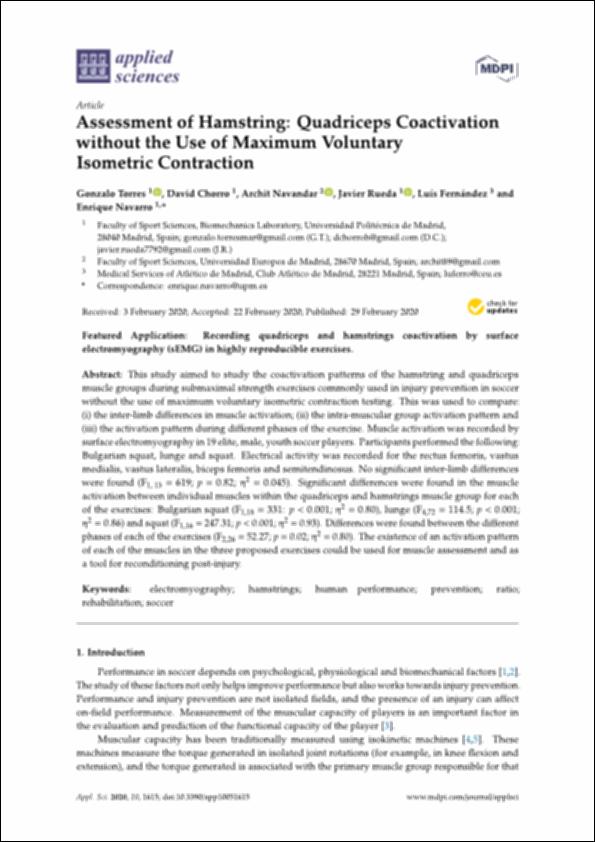Por favor, use este identificador para citar o enlazar este ítem:
http://hdl.handle.net/10637/14714Assessment of Hamstring: Quadriceps Coactivation without the Use of Maximum Voluntary Isometric Contraction
| Título : | Assessment of Hamstring: Quadriceps Coactivation without the Use of Maximum Voluntary Isometric Contraction |
| Autor : | Torres, Gonzalo Chorro, David Rueda, Javier Fernández Rosa, Luis Navarro, Enrique |
| Materias: | Electromyography; Hamstrings; Human performance; Prevention; Ratio; Rehabilitation; Soccer |
| Editorial : | MDPI |
| Citación : | Torres, G.; Chorro, D.; Navandar, A.; Rueda, J.; Fernández, L.; Navarro, E. Assessment of Hamstring: Quadriceps Coactivation without the Use of Maximum Voluntary Isometric Contraction. Appl. Sci. 2020, 10, 1615. https://doi.org/10.3390/app10051615 |
| Resumen : | This study aimed to study the coactivation patterns of the hamstring and quadriceps muscle groups during submaximal strength exercises commonly used in injury prevention in soccer without the use of maximum voluntary isometric contraction testing. This was used to compare: (i) the inter-limb differences in muscle activation; (ii) the intra-muscular group activation pattern and (iii) the activation pattern during different phases of the exercise. Muscle activation was recorded by surface electromyography in 19 elite, male, youth soccer players. Participants performed the following: Bulgarian squat, lunge and squat. Electrical activity was recorded for the rectus femoris, vastus medialis, vastus lateralis, biceps femoris and semitendinosus. No significant inter-limb differences were found (F1, 13 = 619; p = 0.82; 2 = 0.045). Significant di erences were found in the muscle activation between individual muscles within the quadriceps and hamstrings muscle group for each of the exercises: Bulgarian squat (F1,18 = 331: p < 0.001; n2 = 0.80), lunge (F4,72 = 114.5; p < 0.001; n2 = 0.86) and squat (F1,16 = 247.31; p < 0.001; n2 = 0.93). Differences were found between the different phases of each of the exercises (F2,26 = 52.27; p = 0.02; n2 = 0.80). The existence of an activation pattern of each of the muscles in the three proposed exercises could be used for muscle assessment and as a tool for reconditioning post-injury. |
| URI : | http://hdl.handle.net/10637/14714 |
| Derechos: | http://creativecommons.org/licenses/by-nc-nd/4.0/deed.es OpenAccess |
| ISSN : | 2076-3417 |
| Fecha de publicación : | 29-feb-2020 |
| Centro : | Universidad San Pablo-CEU |
| Aparece en las colecciones: | Fisioterapia |
Los ítems de DSpace están protegidos por copyright, con todos los derechos reservados, a menos que se indique lo contrario.


